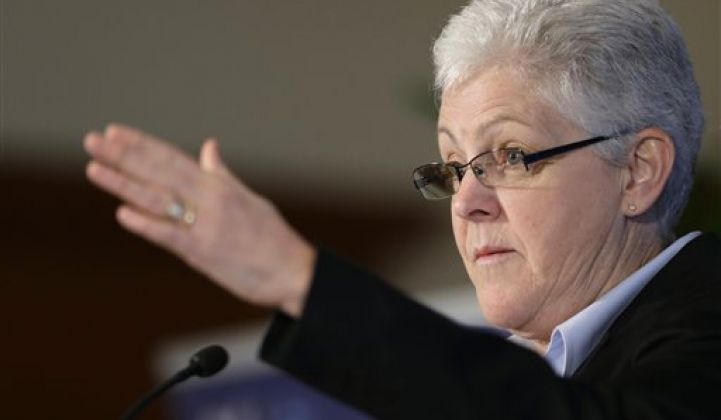When he was first elected to office, President Obama's energy strategy was all about using clean technologies as an economic force.
By spinning positive imagery of green jobs and the clean energy economy, Obama hoped a positive approach would be the way to change the country's energy mix. That plan, implemented largely by the Department of Energy through the stimulus, was all about carrots.
But Obama's new plan, based on phasing out dirty resources through regulation, has a lot more sticks. And that puts a lot of responsibility on the Environmental Protection Agency (EPA).
Enter Gina McCarthy, the newly confirmed EPA administrator.
After getting blocked by Senate Republicans for 136 days, McCarthy was finally confirmed yesterday by a vote of 59-40. Now she is tasked with quickly moving forward on a wide-ranging climate plan that relies heavily on EPA for implementation.
If she succeeds, McCarthy could be one of the most important forces for clean energy in Washington.
However, there's still a big "if."
The main piece of Obama's climate plan is regulation of carbon dioxide emissions from new and existing power plants. This is not a new policy under McCarthy; CO2 regulations for new power plants have been under development at EPA for years after the Supreme Court ruled that the greenhouse gas is a pollutant. But these rules have faced long delays due to legal challenges and failures to meet deadlines.
The new White House climate plan directs the EPA administrator to expedite these rules and get them completed before Obama leaves office. That's a hefty task.
Along with facing heavy industry lobbying and bureaucratic constraints in Washington, EPA must deal with governors and lawmakers in every state where the regulations will be implemented. Because each state must come up with its own plan for meeting the rules, there are a lot of moving parts -- and potential resistance -- on the local level.
Although the climate agenda she must now follow is loathed by Republicans, McCarthy is known as a consensus builder in both parties. She was Mitt Romney's climate change advisor while he was governor of Massachusetts, and she also worked closely with the auto industry to get leading manufacturers on board with aggressive new fuel efficiency standards passed last year.
If McCarthy can win over states and help get the rules in place before the end of Obama's tenure in 2016, she will help set the stage for big changes in the energy sector.
Regulations for new power plants, which have been underway for years, won't have a huge tangible impact. After all, the U.S. Energy Information Administration recently projected that very few new coal plants would be coming on-line between now and 2035.
But rules for existing power plants -- in combination with recently developed rules for mercury and air toxics -- would be a major blow to coal in the U.S. Already, 30 gigawatts of coal are slated for retirement as plants age and face stiff competition from natural gas and renewables. New rules for carbon dioxide emissions would put even more pressure on coal plant operators, resulting in the closure of thousands more megawatts of capacity.
That would open up a massive new opportunity for renewables, CO2 scrubber technology providers, natural gas generators, and potentially companies developing carbon capture and storage technologies.
Since Obama took office and provided incentives for the clean energy industry through the stimulus, U.S. renewable electricity generation has doubled. And although coal has some lost market share -- largely due to cheap natural gas prices -- renewables still only provide a small piece of America's energy mix. New regulations expedited by the EPA would approach the market from the other end of the spectrum, using financial penalties to speed up a transition.
Although the Obama administration refutes that its policy is a "war on coal" as many Republicans have labeled it, the fact remains: strong CO2 standards would hit the coal generation sector hard and provide a boost to clean technologies.
In addition to rolling out new CO2 regulations, McCarthy will also help determine the fate of federal fracking regulations, attempt to finalize mileage standards for heavy-duty vehicles, and strengthen Energy Star efficiency standards.
Of course, Obama's other key cabinet members -- Energy Secretary Ernest Moniz, Interior Secretary Sally Jewell and Agriculture Secretary Tom Vilsack -- are just as important for moving on White House clean energy priorities. But McCarthy has the most pressing and important deadline out of anyone, arguably making her one of the most powerful people with influence over the world of cleantech today.



